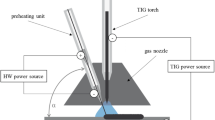Abstract
This work examines the induction heating of a metal sheet to be used for multiple instance melt extraction from the lower edge. The task formulation of heating the edge in first place while keeping the release of Joule heat along that edge as homogeneous as possible, i.e., the avoidance of end effects, is solved numerically with a parametric study. A set of factors is also modeled physically in the framework of an experimental series. Subject to variation are (1) the extension of the copper block, which simulates the extraction wheel, in both directions parallel and perpendicular to the inductor; (2) the protrusion depth of the edge of the sheet below the lower face of the inductor; and (3) the shape of the inductor. It is shown that this shape adopted from the floating zone crystal growth technique in a previous work,[1] albeit acting effectively, is removed from optimum. In this article, a more efficient solution is proposed. The numerical simulations also suggest that the vertical position of the inductor must be significantly above that one in Reference 1 to increase the efficiency of the process. Reasonable conformity may be stated between the calculated and the experimental results.
















Similar content being viewed by others
Notes
Albeit this supposition often does not hold,[2] it should be allowed here for the contemplation of a tendency.
Note in this respect that we are concerned with alternating current of high frequency. To pass the same current through the circular and wedge-shaped inductor in Figure 14, different electrical power is consumed because of the differing impedance of both systems.
References
A. Cramer, V. Galindo, G. Gerbeth, J. Priede, A. Bojarevičs, Y. Gelfgat, O. Andersen, C. Kostmann, and G. Stephani: Metall. Mater. Trans. B, 2009, vol. 40B, pp. 337-44.
A. Cramer and G. Gerbeth: J. Mater. Process. Tech., 2008, vol. 204, pp. 103-10.
R.E. Maringer: U.S. Patent 4,124,664, 1975.
L.A. Schwartzkopf, J.E. Ostensen, and D.K. Finnemore: U.S. Patent 4,970,194, 1990.
J. Ström-Olsen: Mater. Sci. Eng. A, 1994, vol. A178, pp. 239-43.
A. Cramer, J. Priede, V. Galindo, G. Gerbeth, O. Andersen, and C. Kostmann: Proc. Int. Symp. Heating Electromag. Sources, Padua, Italy, 2007, pp. 445–52.
J. Priede, A. Cramer, G. Gerbeth, V. Galindo, O. Andersen, C. Kostmann, and G. Stephani: Patent DE 10,2006,005,510 B4, 2009.
Ansoft Corporation: Maxwell 3D Training Course, Ansoft Corporation, San Jose, CA, 1995–2004, pp. 721–29.
Acknowledgment
Financial support from Deutsche Forschungsgemeinschaft in the framework of the Collaborative Research Centre SFB 609 is acknowledged gratefully.
Author information
Authors and Affiliations
Corresponding author
Additional information
Manuscript submitted March 30, 2010.
Rights and permissions
About this article
Cite this article
Park, JS., Pal, J., Cramer, A. et al. Optimization of Induction Heating for Container-Less Melt Extraction from a Metallic Sheet. Metall Mater Trans B 41, 1074–1083 (2010). https://doi.org/10.1007/s11663-010-9396-y
Published:
Issue Date:
DOI: https://doi.org/10.1007/s11663-010-9396-y




